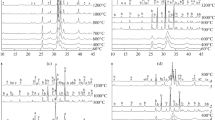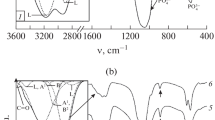Abstract
The first solid to appear in the precipitation of calcium phosphates from basic solutions is structurally non-crystalline. The existence, however, of a solution-prepared, non-crystalline orthophosphate salt is not unique only to the calcium phosphate system. Non-crystalline magnesium phosphates and magnesium ammonium phosphates can also be prepared under comparable conditions, but unlike the calcium salt, which converts into hydroxyapatite, these latter compounds are apparently solution stable. Preparations of strontium and barium orthophosphates from basic solution do not yield non-crystalline intermediates. For strontium, the intermediate phase is Sr3(PO4)2·4H2O, whereas the barium precipitates immediately as a stable barium hydroxyapatite. The tristrontium phosphate, however, converts autocatalytically into strontium hydroxyapatite. The analogous stoichiometry and identical kinetic behavior of the strontium intermediate with that of the amorphous calcium phosphate suggest that the latter could be a tricalcium phosphate rather than a cryptocrystalline Ca-deficient hydroxyapatite. This supports the possibility that the non-crystalline phase in bone mineral may not be an apatite but instead a distinct and separate compound.
Résumé
Le premier solide qui se forme au cours de la précipitation des phosphates de calcium, à partir de solutions basiques, est non-cristallin au point de vue structural. L'existence d'une solution saline non-cristalline d'orthophosphate n'est, cependant, pas propre au système des phosphates de calcium. Des phosphates de magnésium et des phosphates de magnésium — ammonium non-cristallins peuvent également être préparés dans des conditions similaires: mais, contrairement au sel calcique, qui se transforme en hydroxyl-apatite, ces composés sont apparemment stable. Des solutions basiques d'orthophosphates de strontium et de baryum ne forment pas de produits intermédiaires non-cristallins. Pour le strontium, la phase intermédiaire est constituée par le Sr3(PO4)2·4H2O, alors que le phosphate de baryum se précipite immédiatement sous forme d'un hydroxyl-apatite de baryum stable. Le phosphate de tristrontium se transforme cependant par autocatalyse en hydroxylapatite de strontium. La stoïchiométrie similaire et le comportement cinétique identique du produit intermédiaire de strontium avec ceux du phosphate de calcium amorphe semblent indiquer que ce dernier est constitué par un phosphate tricalcique plutôt que par une hydroxyl-apatite crypto-cristalline, déficiente en calcium. Ces faits semblent confirmer la possibilité non-apatitique de la phase non-cristalline du minéral osseux. Il peut s'agir d'un composé séparé et distinct.
Zusammenfassung
Der erste feste Bestandteil, welcher beim Fällen von Calciumphosphat aus alkalischen Lösungen erscheint, ist strukturmäßig nicht-kristallin. Allerdings ist das Vorkommen eines nicht-kristallinen, aus einer Lösung hergestellten Orthophosphatsalzes nicht nur dem Calcium-phosphat-System eigen, können doch auch nicht-kristalline Magnesiumphosphate und Magnesiumammoniumphosphate unter ähnlichen Bedingungen gewonnen werden. Im Gegensatz zum Calciumsalz sind diese Verbindungen jedoch in Lösung anscheinend stabil. Alkalisch hergestellte Lösungen von Strontium- und Barium-Orthophosphaten ergeben keine nicht-kristalline Zwischenverbindungen. Für Strontium ist die intermediäre Phase Sr3(PO4)2·4H2O, während das Barium sogleich als Bariumhydroxyapatit ausfällt. Das Tristrontiumphosphat hingegen verwandelt sich autokatalytisch zu Strontiumhydroxyapatit.
Die ähnliche stöchiometrische Form und das identische kinetische Verhalten der Strontium-Zwischenverbindung mit jener des amorphen Calciumphosphates läßt den Schluß zu, daß das Calciumphosphat eher ein Tricalciumphosphat als ein kryptokristallines, calciumarmes Hydroxyapatit sein könnte. Diese Annahme erhärtet die These, wonach die nichtkristalline Phase im Knochenmineral kein Apatit, sondern eine bestimmte, eigenständige Verbindung wäre.
Similar content being viewed by others
References
Bachra, B. N., O. R. Trautz, andS. L. Simon: Precipitation of calcium carbonates and phosphates. III. The effect of magnesium and fluoride ions on the spontaneous precipitation of calcium carbonates and phosphates. Arch. oral. Biol.10, 731–738 (1965).
Collin, R. L.: Preparation and properties of two strontium orthophosphates — Sr3(PO4)2· 4H2O and Sr6H3(PO4)5·2H2O. J. Chem. Eng. Data9, 165–166 (1964).
Denk, G., andB. Hoppel: The precipitation of strontium and barium phosphates. Z. anorg. allg. Chem.310, 185–194 (1961).
Eanes, E. D., I. H. Gillessen, andA. S. Posner: Intermediate states in the precipitation of hydroxyapatite. Nature (Lond.)208, 365–367 (1965).
———: Mechanism of conversion of non-crystalline calcium phosphate to crystalline hydroxyapatite. In: Crystal growth (H. S. Peiser, ed.), p. 373–376. New York: Pergamon Press 1967.
—,R. A. Harper, I. H. Gillessen, andA. S. Posner: An amorphous component in bone mineral. In: Fourth European Symposium on Calcified Tissues (P. J. Gaillard, A. Van den Hoff, andR. Steendijk, eds.), p. 24–26, Internat. Congr. Series No 120. Amsterdam: Excerpta Medica 1966.
Eanes, E. D., andA. S. Posner: Kinetics and mechanism of conversion of non-crystalline calcium phosphate to crystalline hydroxyapatite. Trans. N.Y. Acad. Sci.28, 233–241 (1965).
—,J. D. Termine, andA. S. Posner: Amorphous calcium phosphate in skeletal tissues. Clin. Orthop.53, 223–235 (1967).
Gee, A., andV. R. Deitz: Determination of phosphate by differential spectrophotometry. Anal. Chem.25, 1320–1324 (1953).
Harper, R. A., andA. S. Posner: Measurement of non-crystalline calcium phosphate in bone mineral. Proc. Soc. exp. Biol. Med.122, 137–142 (1966).
Kerr, G. T.: Chemistry of crystalline aluminosilicates. I. Factors affecting the formation of zeolite A. J. Phys. Chem.70, 1047–1050 (1966).
Klement, R., andP. Dihn: Basic phosphates of bivalent metals. III. Barium hydroxyapatite. Z. anorg. allg. Chem.240, 31–39 (1938).
Mooney, R. W., andM. A. Aia: Alkaline earth phosphates. Chem. Rev.61, 433–462 (1961).
Prien, E. L., andC. Frondel: Studies in urolithiasis. I. The composition of urinary calculi. J. Urol. (Baltimore)57, 949–991 (1947).
Ropp, R. C., M. A. Aia, C. W. W. Hoffman, T. J. Veleker, andR. W. Mooney: X-ray powder diffraction patterns of strontium phosphates. Anal. Chem.31, 1163–1166 (1959).
Termine, J. D., andA. S. Posner: Amorphous/Chrystalline interrelationships in bone mineral. Calc. Tiss. Res.1, 8–23 (1967).
Woodward, H. Q.: The elementary composition of human cortical bone. Hlth Phys.8, 513–517 (1962).
Author information
Authors and Affiliations
Additional information
This work supported in part by PHS Grant DE-09145 from the National Institute of Dental Research, USA. Publication Number 44 from The Laboratory of Ultrastructural Biochemistry.
Rights and permissions
About this article
Cite this article
Eanes, E.D., Posner, A.S. Intermediate phases in the basic solution preparation of alkaline earth phosphates. Calc. Tis Res. 2, 38–48 (1968). https://doi.org/10.1007/BF02279192
Received:
Issue Date:
DOI: https://doi.org/10.1007/BF02279192




